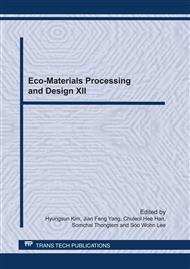p.377
p.381
p.385
p.389
p.393
p.397
p.401
p.405
p.409
Fabrication and Cytotoxicity Studies of the TiO2 Doped with Copper-Based Nanocomposite Particles
Abstract:
Since the growing interest in the manufacture and environmental applications of nanocomposites consisting of CuO and TiO2 nanoparticles (NPs), related toxicological effect and interaction with cellular structures for these newly developed materials are still unknown. Recent literature reveals that nanosized CuO and TiO2 particles have cytotoxicity risks and ability to cause oxidative stress on health. This work considers the CuO doped TiO2 nanocomposite particles were synthesized via a coprecipitation method with aqueous solutions as precursors of copper nitrate and titanium dioxide. Moreover, the nanocomposite particles were characterized using TGA-DTA, UV-Vis and TEM measurements. The calcination temperature was selected at 873 K. The nanocomposite particles were characterized by TEM, as the primary particles, aggregates ranged from 30 to 100 nm and have a good dispersion character. Cell cytotoxicity assessment and the percentage cell survival was determined by using 3-(4,5-dimethylthiazol-2-yl)-5(3-carboxymethoxyphenol)-2-(4-sulfophenyl)-2H-tetrazoli um (MTS) assay on human fetal lung tissue cell (MRC-5). The experimental results show that the CuO doped TiO2 nanocomposite particles cause potential cytotoxicity effect in cultured human cells.
Info:
Periodical:
Pages:
393-396
Citation:
Online since:
July 2011
Authors:
Keywords:
Price:
Сopyright:
© 2011 Trans Tech Publications Ltd. All Rights Reserved
Share:
Citation:


